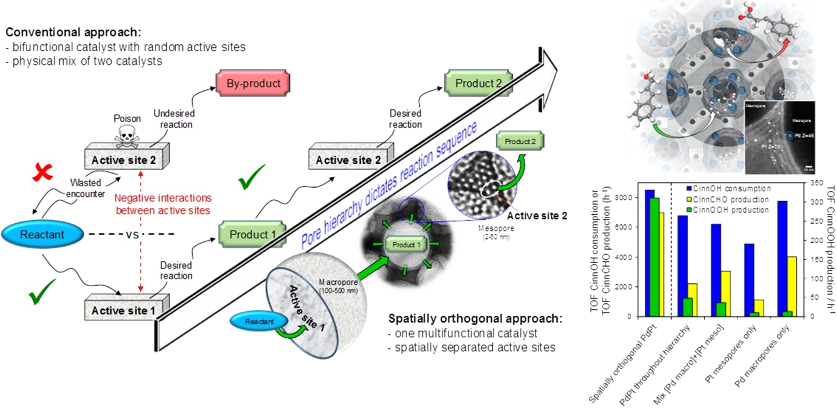Catalysis is a key enabling technology contributing to 35 % of the global economy, with new catalysts underpinning socioeconomic advancement through fuels, chemicals, and pharmaceuticals production, and environmental depollution.
Project dates: 2020-23
Grants and funding: ARC DP200100204
Description
Catalysis is a key enabling technology contributing to 35 % of the global economy, with new catalysts underpinning socioeconomic advancement through fuels, chemicals, and pharmaceuticals production, and environmental depollution.
This project aims to develop and implement new strategies to create, visualise, and apply multifunctional catalysts in which the location of (and communication between) active sites is precisely controlled to unlock ultraselective cascade reactions. Cascades offer great advantages in respect of process efficiency and waste minimisation. In addition to their intrinsic elegance, cascade reactions thus represent a key green chemical technology by which to reduce the number of manipulations required for the manufacture of pharmaceuticals and fine chemicals.[1] The goal is improved, and entirely new, cascade processes for the production of sustainable biofuels, agrochemicals, bio-based platform chemicals, and pharmaceutical intermediates.
Research strategy
Cascade reactions are sequential chemical transformations in which the starting substrate undergoes a reaction whose product becomes the substrate for the next step, and so on, until a stable product is reached. However, catalytic cascades, in which the product of a reaction catalysed by species A undergoes a subsequent, distinct transformation catalysed by a second species B, are hindered by undesired interactions between the initial substrate and the second active species, or indeed between the two catalytic species (e.g. an acid and base). We recently discovered a revolutionary yet versatile solution to the above problems that enables control over the position of chemically and/or physically different components within three-dimensional architectures.[2] This solution, by which chemically distinct functionalities can be introduced in a spatially orthogonal (mutually exclusive) fashion, offers unparalleled control over sequences of chemical reactions in porous solid catalysts (Figure 1).
 Figure 1. (left) Spatially orthogonal chemically functionalised Pd macroporous-Pd mesoporous SBA-15, and (right) catalytic advantage for the aerobic selective oxidation of cinnamyl alcohol.
Figure 1. (left) Spatially orthogonal chemically functionalised Pd macroporous-Pd mesoporous SBA-15, and (right) catalytic advantage for the aerobic selective oxidation of cinnamyl alcohol.
New families of spatially orthogonal catalysts will be synthesised and characterised by advanced analytical techniques, including electron microscopy, XPS, XRD, DRIFTS, and diffusion NMR, in collaboration with the Universities of Cambridge and Manchester and through accessing international synchrotron light sources.
Rationale
This project will underpin the sustainable manufacturing of low carbon fuels and high value chemicals from underexploited waste resources, with the potential to enhance Australian energy security, and to strengthen and diversify the Australian agricultural and chemical manufacturing sectors through new investment opportunities and associated job and wealth creation. Cleaner routes to the production of renewable transport fuels and high value chemicals, including renewable and biodegradable polymers and plastics, from industrial, municipal, and agricultural waste, will reduce water and energy consumption and help to protect and clean-up rural and urban environments, and to mitigate marine microplastic pollution.
Key people
Professors Adam Lee and Karen Wilson
Associated journal publications
- M.J. Climent, A. Corma, S. Iborra, M.J. Sabater, ACS Catal. 2014, 4, 870.
- C.M.A. Parlett, M.A. Isaacs, S.K. Beaumont, L.M. Bingham, N.S. Hondow, K. Wilson, A.F. Lee, Nature Mater. 2016, 15, 178.
- C.M.A. Parlett, K. Wilson, A.F. Lee, Chem. Soc. Rev. 2013,42, 3876.


